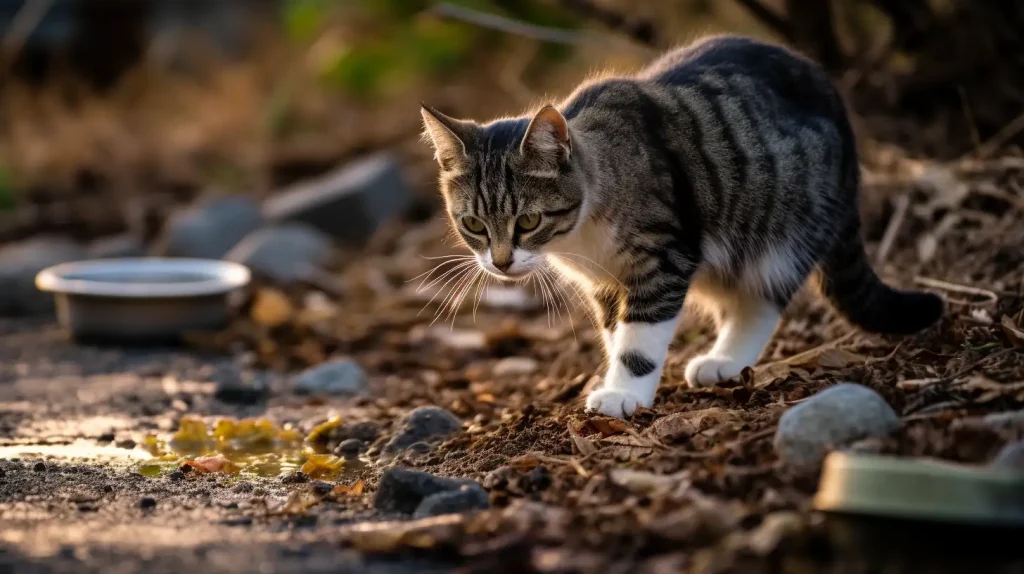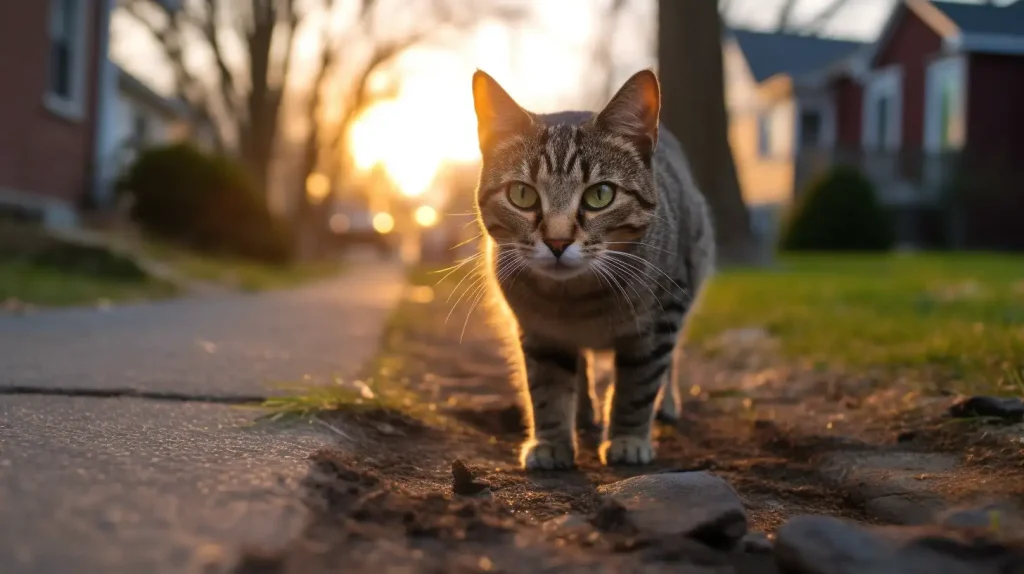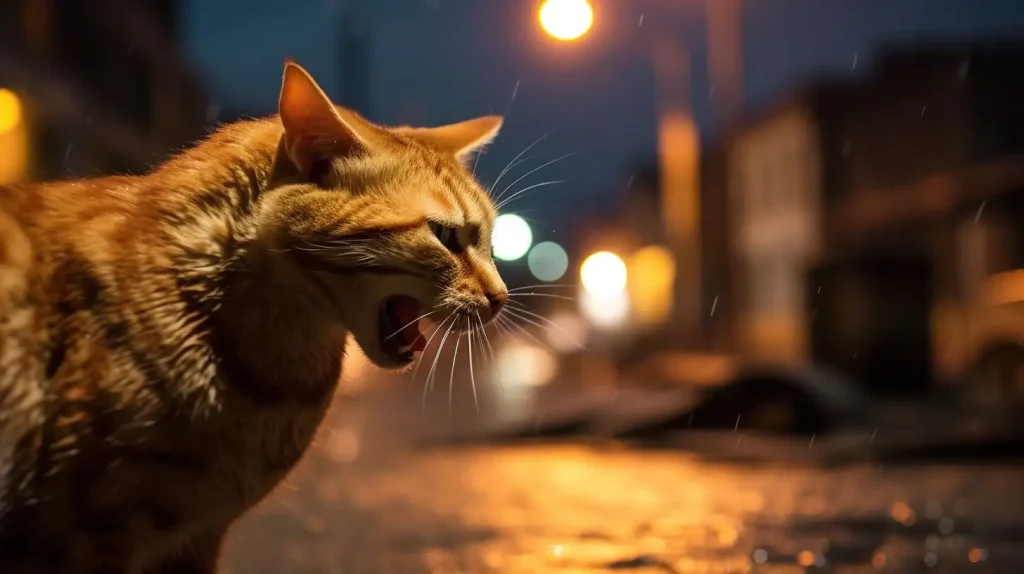Table of Contents
Key Takeaways
- Why do stray cats poop in my yard, you might ask. Well, stray cats poop in yards due to scent-based social dynamics and preferences for safety and convenience.
- Proximity to food sources can attract cats to certain areas for their bathroom needs.
- Cat feces pose health risks, carrying parasites and pathogens harmful to humans and other pets.
- Cat waste can damage lawns and plants due to high nitrogen levels and disruptive digging behavior.
- Stray cat poop can negatively impact the aesthetics of a well-kept yard, affecting outdoor enjoyment.
- Solutions include water spray deterrents, technology-based devices like ultrasonic repellents, and altering the environment.
- Community efforts, such as TNR (Trap-Neuter-Return) programs, help manage stray cat populations humanely.
- Implementing a comprehensive plan combining multiple methods is more effective in keeping yards cat-free.
Hello there, fellow cat admirer (or exasperated homeowner)! Have you been finding unwelcome presents from neighborhood cats in your yard? If so, you’re not alone. Many of us have faced this predicament at one point or another. But why do stray cats choose your yard as their personal toilet? This article aims to shine a light on the somewhat mysterious reasons behind this behavior, as well as to provide practical and humane solutions.
Stray Cat Behavior: Why Your Yard?
When a stray cat decides to use your yard as its bathroom, it’s not doing it to annoy you. This behavior is rooted in the nature of cats and how they communicate with their environment.
Territorial Marking: Understanding Feline Communication through Scents
Cats, both domestic and stray, use their feces and urine to mark territory. It’s their version of a “Keep Out” sign. By leaving their scent in your yard, they’re communicating to other cats that this area is already claimed. In the feline world, this scent-based messaging system is an essential part of social dynamics.
Safety and Convenience: Exploring Why Cats Choose Specific Locations for Their Business
Cats also prefer to do their business in places that provide a certain degree of safety and convenience. Your yard might have areas that are quiet, hidden from view, or easy to dig in. These conditions make it an ideal spot for a cat to relieve itself. Think about it from their perspective: wouldn’t you prefer a private, peaceful toilet too?
Food Sources: The Proximity Factor
The presence of a food source nearby can also affect where a cat decides to poop. If you or your neighbors are feeding stray cats, they might choose to poop in your yard for the sake of convenience.
Familiarity and Habit: Cats and Their Routines
Cats are creatures of habit. Once they’ve found a spot that they deem safe and comfortable, they tend to stick to it. This habitual behavior can explain why a stray cat keeps returning to your yard to poop.
The Impact of Weather
You might be surprised to learn that weather plays a significant role in where a stray cat chooses to “do its business.” Just like us, cats prefer to keep dry and avoid unpleasant weather conditions.
Wet Weather Conditions
When it’s raining or has recently rained, the stray cats in your neighborhood might be seeking sheltered spots to relieve themselves. This could mean closer to your house, under your porch, or even in your garage if they can access it. They’re simply trying to avoid getting wet, just as we would dash from the car to the house to avoid getting soaked.
Dry and Warm Conditions
In contrast, during dry and warm weather, cats might venture further into your yard, particularly to areas where the soil is soft and easy to dig in. You might notice more “presents” in your flower beds or vegetable garden during these conditions. Remember, they’re not out to sabotage your prized petunias, it’s just that the loose, warm soil makes a very inviting bathroom for our feline friends.
By understanding how weather affects these behaviors, we can better tailor our strategies for deterring cats from specific areas of our yards and guide them to more appropriate spots.

The Impact of Stray Cats Pooping in Your Yard
Having stray cats use your yard as a litter box isn’t just an inconvenience. It can also have health implications and cause damage to your garden.
Health Risks
Cat feces can carry parasites and pathogens that can pose health risks to humans and other pets. Toxoplasmosis and roundworms are just two examples. This is why it’s important to clean up after stray cats and take measures to deter them from pooping in your yard.
Damage to Lawn and Plants
Aside from the health risks, cat feces can also damage your lawn and plants. The high concentration of nitrogen in cat waste can “burn” plants and create unsightly spots in your lawn. Additionally, cats digging in the soil to bury their waste can also disrupt plant growth.
Unpleasant Odors
Let’s face it: cat poop stinks. Having stray cats regularly pooping in your yard can lead to persistent unpleasant smells that can ruin your enjoyment of your outdoor space.
The Aesthetics
Imagine stepping outside on a beautiful summer day, coffee in hand, ready to enjoy the serenity of your garden… only to be met with the sight (and smell) of stray cat poop. This unwelcome discovery can certainly put a damper on your day. The aesthetic appeal of a well-kept yard plays a huge role in our enjoyment of our outdoor spaces. Not only can cat feces be visibly off-putting, but the act of cats digging in the yard to bury their waste can disrupt your carefully manicured flower beds or neatly trimmed lawn. Regularly having to dodge these messy surprises can also make you think twice about outdoor activities. A spontaneous picnic or an afternoon of gardening quickly becomes less appealing with the presence of cat poop. As such, managing this issue can significantly improve the appearance of your yard, and by extension, your enjoyment of it.
How to Prevent Stray Cats from Pooping in Your Yard: Practical and Humane Solutions
So, how can you discourage stray cats from turning your yard into their toilet? Here are some practical and humane solutions you can try.
Altering the Environment
Making your yard less appealing to cats can be an effective deterrent. You can do this by planting cat-repellent plants like lavender, rosemary, or rue. Cats also dislike walking on certain textures, so you can lay down chicken wire, pebbles, or pine cones around your yard.
Safe Repellents
There are several natural and commercial repellents that are safe to use around cats. Citrus peels, coffee grounds, and vinegar are examples of natural repellents you can try. Commercial options include sprays and granules that are designed to deter cats without causing them harm.
Lighting and Noise
Motion sensor lights or noise makers can startle cats and make them think twice about entering your yard. Cats prefer to poop in peace, so a sudden flash of light or a loud noise can be quite off-putting.
Providing Alternatives
Another strategy is to set up a designated area for cats to poop in. This could be a sandbox or a loose soil area. By making this area more appealing (think easy to dig and private), cats may choose to use it instead of your lawn or flower beds.
Utilizing Water
When it comes to feline deterrence, water can indeed be your secret weapon. Most cats, as you may well know, aren’t particularly fond of getting wet. They’re fastidious creatures, spending up to half their awake time grooming and maintaining their fur to perfection. Therefore, a surprise spritz from a sprinkler or a strategically positioned water deterrent can effectively discourage them from entering your yard. Consider installing a motion-activated sprinkler system. These systems detect movement within a certain radius and send out a harmless yet startling burst of water. Not only do these systems keep cats at bay, but they can also help keep your lawn lush and green. Similarly, there are also commercially available water spray deterrents. Compact and easy to install, these devices emit a harmless spray of water when they sense movement, making your yard less appealing to our feline friends. Remember, the goal here is not to soak or scare the cat excessively, but to create an environment that they’d rather avoid, steering them towards safer and more appropriate places to do their business.
Removing Attractions
When it comes to stray cats turning your yard into their personal oasis, it’s important to remember one thing: they’re attracted to certain elements that your yard might be offering. It’s like an all-inclusive resort for them, but to your dismay! So, the first step towards turning them away is by making your yard less appealing.
If you or your neighbors are leaving food outside, it’s like ringing the dinner bell for these furry friends. Outdoor pet food dishes, bird feeders, or unsecured trash bins – they’re all easy food sources for stray cats. Making sure to remove or secure these food sources can significantly decrease the attractiveness of your yard. Try feeding your pets inside and securing your trash cans with tight lids.
Next, let’s talk about shelter. Cats love cozy, hidden places like thick shrubs, underneath porches, or piles of wood or debris. These spots offer protection from predators and harsh weather conditions. By removing potential hiding places, or blocking access to them, you’re effectively making your yard less inviting. Do a walk-around and identify any potential “cat magnets”. Trim thick bushes, seal off entry points to under your house, and keep your yard tidy and free from debris.
The Use of Technology
In our tech-savvy world, it’s no surprise that there are innovative solutions to help deter stray cats from using your yard as a litter box. One such method involves the use of ultrasonic devices. These handy gadgets emit a high-frequency sound that is unpleasant (but not harmful) to cats, encouraging them to vacate the area. Often solar-powered and equipped with motion sensors, they’re easy to install and environmentally friendly. Most humans can’t hear these frequencies, so you won’t need to worry about any annoying background noise. Keep in mind that these devices should be just one part of your comprehensive plan to keep your yard cat-free, and they work best in combination with other methods mentioned earlier, like altering the environment and using safe repellents. Embracing technology can help you take an extra step towards reclaiming your garden, all the while ensuring our feline friends are gently encouraged to find alternative locations for their bathroom needs.

Community Efforts and TNR
Aside from the solutions you can implement in your own yard, there are also community efforts that can help manage stray cat populations.
The Role of Community Efforts
Communities can work together to manage stray cats in a way that is humane and effective. This can involve setting up feeding stations, providing shelter, and implementing TNR programs.
Understanding TNR Programs
TNR stands for Trap-Neuter-Return. It’s a method that involves trapping stray cats, neutering them, and then returning them to their territory. TNR programs are effective in controlling stray cat populations and reducing behaviors like yowling, spraying, and fighting.
Getting Involved in TNR Programs
You can get involved in TNR programs by volunteering, donating, or even starting your own program. Many animal welfare organizations offer training and resources for those interested in participating in TNR efforts.
Educating the Community
It’s worth noting that managing the issue of stray cats using our yards as personal litter boxes isn’t a solo mission; it’s a community effort. Why so? Well, cats, especially the free-roaming ones, rarely limit their activities to a single yard or property. As such, the problem extends beyond your own fence line and often involves your neighbors, whether they realize it or not.
The Power of Awareness
But here’s the thing: many folks simply might not be aware of the extent of the issue or the implications it carries. And that’s where community education comes into play. Informing your neighbors about why stray cats are attracted to yards, the potential risks involved, and the effective methods to humanely deter these feline visitors can make a significant difference.
Spreading the Word
How can you go about this? You might consider holding a neighborhood meeting, distributing informative leaflets, or creating a community social media group. The aim is to create a shared understanding of the problem and collaborate on effective solutions. Remember, this isn’t about demonizing our furry wanderers but promoting co-existence through understanding and kindness.
The Ripple Effect
Imagine the impact if every household in your neighborhood implemented just one or two of the cat-deterring strategies discussed in this article. The combined effect would not only reduce the number of unwanted ‘gifts’ in your yards, but also contribute to the health and wellbeing of the local cat population. Indeed, knowledge is power, and in this case, it’s the power to create a happier, healthier environment for both the human and feline members of your community.
When to Seek Professional Help
Sometimes, despite your best efforts, you might need to call in the professionals.
Evaluating the Extent of the Issue
If you’re dealing with a large number of stray cats or if your attempts to deter them have been unsuccessful, it might be time to seek professional help.
What to Expect from Professional Animal Control Services
Professional animal control services can help trap stray cats safely and humanely. They can also assist with neutering and rehoming efforts, if necessary.
Ensuring Humane Treatment
When choosing an animal control service, make sure they follow ethical and humane practices. Cats should be handled gently and respectfully, and lethal control methods should never be used.
Why Do Stray Cats Poop in My Yard – Conclusion
Understanding why stray cats choose your yard as their bathroom and implementing humane solutions is key to finding coexistence. By creating a cat-deterrent environment, spreading awareness, and collaborating with your neighbors, you can reduce unwanted gifts and contribute to the wellbeing of both your yard and the local cat population. Let’s strive for a harmonious relationship with our feline friends through kindness and empathy.
FAQs
Q: Why do stray cats choose my yard as their bathroom?
A: Cats choose their bathroom spots based on a variety of factors. This can include territorial marking, safety and convenience, proximity to food sources, and habitual behavior. Once a cat finds a spot that meets these criteria, it tends to stick to it.
Q: Are there health risks associated with stray cats pooping in my yard?
A: Yes, there can be. Cat feces can carry parasites and pathogens that can pose health risks to humans and other pets, such as Toxoplasmosis and roundworms. It’s important to clean up after stray cats and take measures to deter them from pooping in your yard.
Q: What are some ways to prevent stray cats from pooping in my yard?
A: There are several practical and humane strategies you can use. Altering the environment by using cat-repellent plants or textures, using safe repellents, setting up motion sensor lights or noise makers, and providing alternatives like a designated sandbox can help deter cats.
Q: What is a TNR program and how can it help with this issue?
A: TNR stands for Trap-Neuter-Return. It’s a method that involves trapping stray cats, neutering them, and then returning them to their territory. TNR programs help control stray cat populations and reduce behaviors like territorial marking.
Q: How can I involve my community in managing this issue?
A: Educating your community about the issue can lead to more effective solutions. This can involve raising awareness about the behavior of stray cats, the potential risks involved, and the humane methods to deter them. You can also encourage your community to participate in TNR programs.
Q: When should I consider seeking professional help?
A: If you’re dealing with a large number of stray cats or if your attempts to deter them have been unsuccessful, it might be time to seek professional help. Choose a professional animal control service that follows ethical and humane practices.



